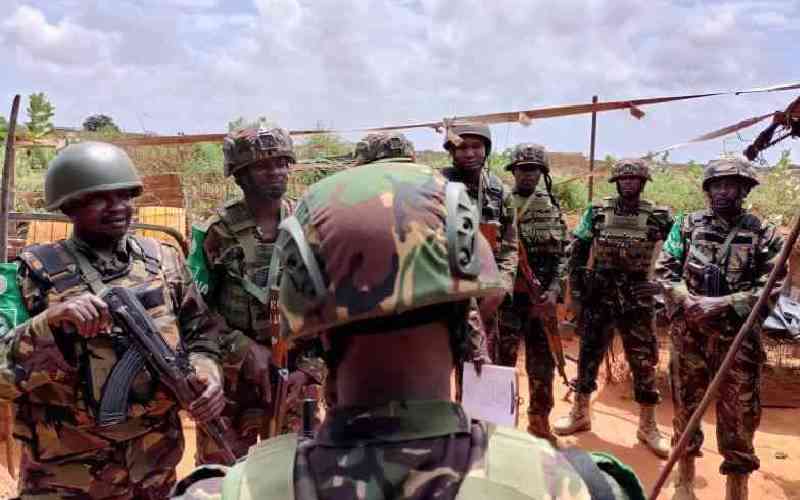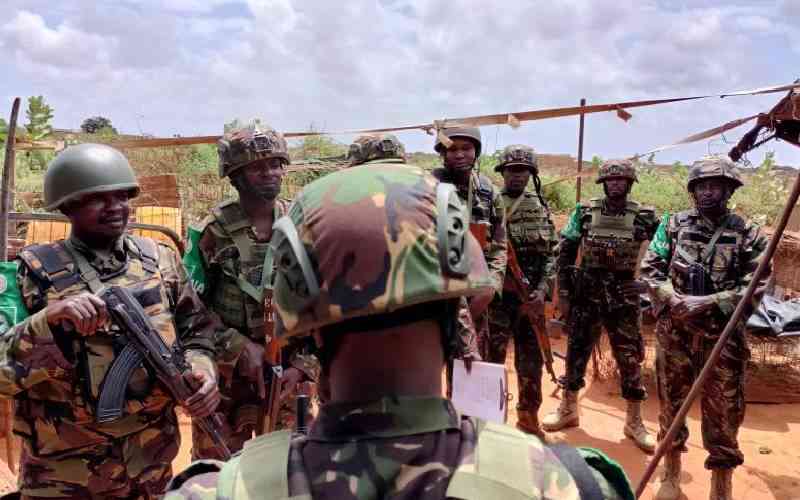Four years after the incursion, Kenya Defence forces are still hunting down for al Shabaab militants in Somalia. Kenya’s entry into Somalia under African Union Mission to Somalia forced al Qaida affiliated militia group to leave Somalia’s capital, Mogadishu which they nearly placed under their control in 2011.
Kenyans have been waiting for official communication about the exact number and fate of KDF soldiers who were ambushed by the militants on Friday 15th January 2016; but even then, more intriguing factor would be to make a hands-on assessment of AMISOM bases in Somalia. Probably, to make an empirical sense and analysis on what went wrong during the dawn attack.
Military hardly provide exact numbers on troopers
Kenyan media has over the past one week been fixated with asking questions of the fate and number of the dead and missing soldiers. Of course, KDF led by Chief of Defence Forces, Gen. Samson Mwathethe has been giving answers which seemingly are not adequate, at least for now, and for a very good reason. Mwathethe says that the operation to rescue Kenyan troopers is still ongoing and as such he doesn’t have all the details on the fate of the company of KDF soldiers in El Adde camp. "There will be the missing, the dead and the injured. DNA has to be done on some of the fallen soldiers and the families have been asked to assist in this process," he said.
In the natural, militaries hardly give details about figures concerning their troops. In fact, historically, KDF has never and may never give exact details about the size of their troops – whether graduates, the death or even the living – but this doesn’t apply in the face of tragedy like the El Adde massacre.
The Islamist militants say they killed more than 100 Kenyan troops in the attack, which would make it the deadliest attack on Kenya's military. But on winding back the actions that unfolded during the martial bout, it’s not enough to know the exact number of the killed, missing or captured soldiers.
Establishment of military camp
The commander of Somali troops in the Gedo region, General Abbas Ibrahim Gurey sensationally claimed that Kenya was given "clear and reliable intelligence" about the threat. Even though KDF has not responded to General Abbas’ claims, it’s no doubt that soldiers will always stay alert to any form of threat – with or without any intelligence.
Nearly all military undertakings are programmed in clear systems which must be followed without any failure. Every military may device their own systems which are secretive and can only be disclosed to specified individuals under code prescriptions. However there are generalities in the establishments of certain infrastructural compounds like military bases.
Unless there are crucial combat intelligence in the hands of the enemy, even their thousands al Shabaab is not capable of overrunning a military base of a complete company.
The El Adde base was a typical Combat outpost with extra-legal jurisdictions not subject to civil applications. Such facilities are directly owned and operated by or for the military or one of its branches that shelters military equipment and personnel, and facilitates training and operations.
There are a lot considerations that go into the establishment of a military base, but most of them are grounded on safety and intelligence gathering. As a requirement, a military base shouldn’t located in an area that is easily monitored from a distance. The exercise of creating a military camp involves a research paper that will scrutinize historical facts of the local population, geographical proficiency and intelligence connects.
In essence, the local population must support the cause and course of the military base. At times, a military may decide to relocate the local population if at all its deemed fit and ethical to do so. Out of observations, it’s not clear whether the local population in El Adde support the presence and actions of KDF in Somalia. However, it’s no doubt that a section of the local population in El Adde massed to witness the humiliation against KDF soldiers. “I’m surprised that when you look at the photos which were being taken, even the residents of El Adde were squatting, taking photos of the slain soldiers,” Security Analyst Mwenda Mbijiwe. “This may mean that they don’t appreciate the sacrifice by KDF soldiers,” he added.
Where was modern day technology in El Adde
Stay informed. Subscribe to our newsletter
The establishment of military camp factors in Observation posts (OPs) which are used for provision and receivership of precise intelligence. These are vital locations with technical capacity to spot the enemy and neutralize the enemy when necessary. Internal observation posts are manned 24 hour, seven days a week. OPs are hardly discussed in the media since they can lead to insecurity of the soldiers.
Modern day observation posts have surveillance installations which can detect potential enemy while seven kilometers away. Some of these shadowing reconnaissance installations can pick a single moving target while it’s miles away from the safety of the soldiers. These are actionable intelligence which [surely] should have saved KDF soldiers in El Adde. Gunships such as Lockheed AC-130 are heavily armed, with long-endurance ground-attack variant of the C-130 Hercules transport aircraft, and can outfox an enemy who is over seven kilometers from an OP or a military base like that of El Adde.
Besides, nearly any modern day military uses Synthetic Aperture Radar (SAR), or SAR, an airborne or space borne side looking radar system which utilizes the flight path of the platform to simulate an extremely large antenna or aperture electronically so as to generate high-resolution remote sensing imagery in order to detect and neutralize an enemy from several kilometres away. A military organization like AMISOM should be using these technologies at all times so as to keep soldiers safe especially when they are resting. This begs the question, “what failed, and when did it fail?”
 The Standard Group Plc is a
multi-media organization with investments in media platforms spanning newspaper
print operations, television, radio broadcasting, digital and online services. The
Standard Group is recognized as a leading multi-media house in Kenya with a key
influence in matters of national and international interest.
The Standard Group Plc is a
multi-media organization with investments in media platforms spanning newspaper
print operations, television, radio broadcasting, digital and online services. The
Standard Group is recognized as a leading multi-media house in Kenya with a key
influence in matters of national and international interest.
 The Standard Group Plc is a
multi-media organization with investments in media platforms spanning newspaper
print operations, television, radio broadcasting, digital and online services. The
Standard Group is recognized as a leading multi-media house in Kenya with a key
influence in matters of national and international interest.
The Standard Group Plc is a
multi-media organization with investments in media platforms spanning newspaper
print operations, television, radio broadcasting, digital and online services. The
Standard Group is recognized as a leading multi-media house in Kenya with a key
influence in matters of national and international interest.







